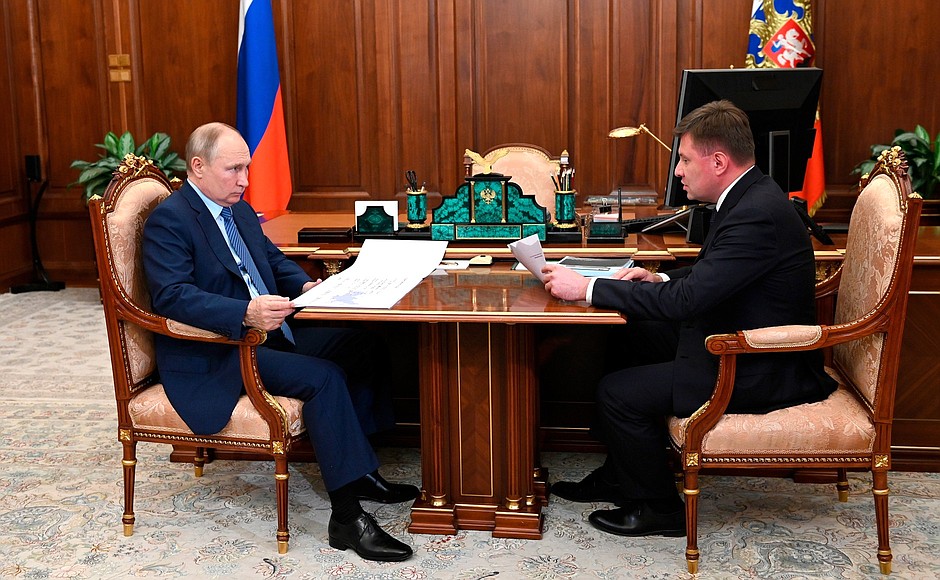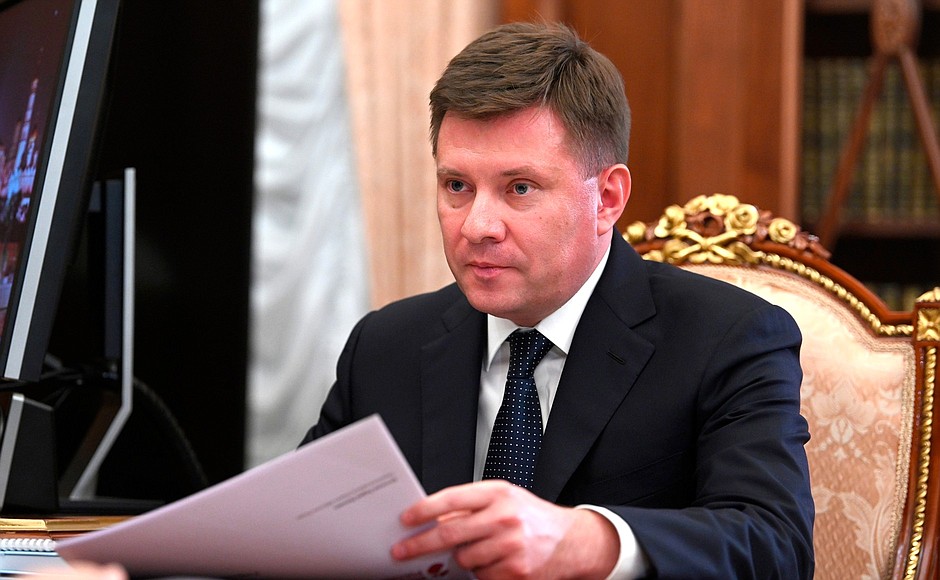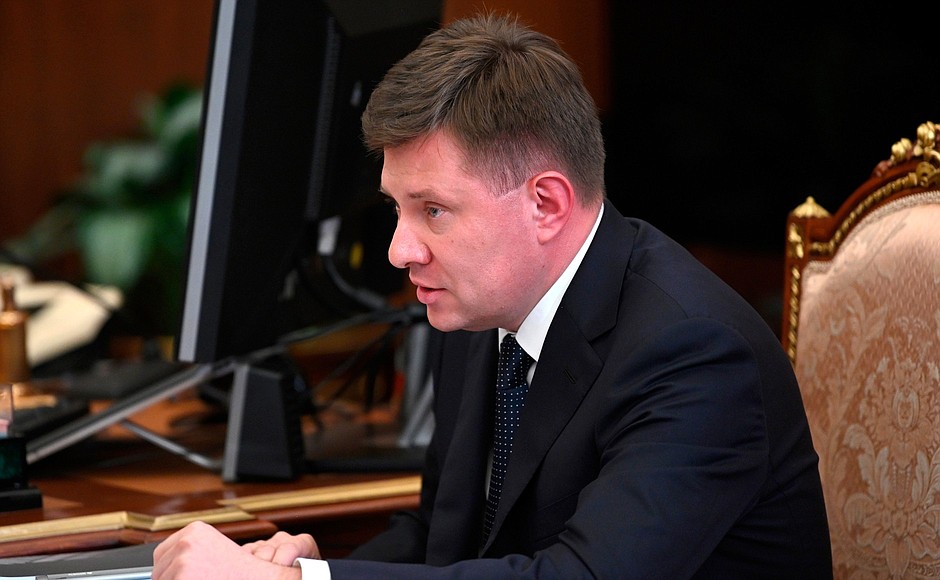President of Russia Vladimir Putin: Mr Boginsky, the national helicopter industry has always flourished, and we have always felt rightfully proud of it. To the best of my knowledge, 8,000 Russian-made helicopters are now in use in 100 countries.
Director General of Russian Helicopters Andrei Boginsky: Yes, that is right.
Vladimir Putin: Your company has become large and efficient. Let’s discuss its performance and prospects.
Andrei Boginsky: Mr President, first I would like to mention some basic corporate data. We are located in several time zones. We have enterprises in the Far East, Siberia, the Ural area, Central Russia and even in the western-most region, namely, Kaliningrad. The holding employs over 38,000 people.
As you have already noted, today, over 8,000 civilian and military helicopters are being used in the Russian Federation and all over the world. More than 430 companies use them. State support allows us to manufacture about 360 helicopters annually.
The holding also has two enterprises that design and manufacture vital units, including reduction gears …
Vladimir Putin: You have three design bureaus, right?
Andrei Boginsky: Yes, three design bureaus. The National Centre for Helicopter Engineering is now one company and unites the Mil and Kamov design bureaus. We have a new design bureau called VR-Technologies, and I will discuss its performance later on. The Kazan Helicopter Plant has its own design bureau that makes the well-known Ansat helicopter which is involved in the air ambulance programme.
Above all that, we provide after-sales maintenance for our helicopters. We operate six aircraft repair centres here in Russia and have ten more partner centres abroad that service both civil and military aircraft.
We are also working to upgrade and open ten more service centres in cooperation with our partners. While the maintenance centres in Russia have been part of the holding and the majority of them were handed over to us by the Defence Ministry (the centre in Novosibirsk was our own from the start), when it comes to foreign service centres, they are the result of our partnerships, which largely depend on the volume of exports. The more we supply, the more services they need to provide.
We currently have three joint ventures with our foreign partners. The first joint venture, with Agusta in Italy, is based in the Moscow Region. It is an assembly facility for Agusta 139 helicopters.
I would like to tell you about our results of the past five years and our plans until 2025 and 2030.
In the past five years, we supplied 865 gas turbine helicopters to the domestic and foreign markets. It is the second highest result in the world for civil and military aircraft. In 2017, we significantly increased the share of civil helicopters and maintained this result in the subsequent years.
As a result, we have been able to ensure that the holding makes profit during the general decline on the global helicopter market and despite the drop in state defence orders and decreasing military technical cooperation. Overall, the general decline on the global market has been 30–35 percent since 2016. But thanks to our own work, to the support from the state and your personal support, Mr President, we have increased the share of civil aircraft, specifically ambulance aircraft. Today we are the second largest manufacturer and supplier of helicopters, which is a reason to be proud.
In the next five years, we plan to increase our key performance indicators. We plan to produce and sell over 1,100 helicopters domestically and abroad by the end of 2025. We expect our share of civil aircraft to exceed 50 percent by 2023.
To maintain our leading positions in the world, we are working to increase production and revenue threefold and consolidated profits fourfold by 2030 compared to 2020. This is our goal for 2030.
We plan to attain this ambitious goal thanks to the broad range of our products. They are widely represented in various sectors. Today our commercially produced combat and military transport helicopters allow us to fully meet the demands of our main client – the Defence Ministry, as well as other law enforcement agencies, and to hold leading positions in the supply of military products to international markets, with active support from Rosoboronexport.
We also produce competitive civilian equipment of various applications. The Mi-8 helicopter and its modifications are holding the lead in the segment of heavy utility helicopters. The Ansat, Ka-226, Ka-32 and Mi-26 helicopters comprise the basis for our expansion in other segments.
You have first-hand knowledge of many of these models, because you have been using them. We are proud of this and regard this as a high assessment of the work of our personnel.
At the same time, we understand that to keep our position in the market we must continue to modernise our products and market new models. Therefore I would like to tell you about our main projects, first in the civilian and after that in the military segment.
Mr President, I would like to tell you about the Mi-171A3 helicopter, a special project we are creating for flights over water bodies to offshore drilling rigs. It meets the international industry standards of the International Association of Oil and Gas Producers. When we market this helicopter, the Russian companies that are involved in joint international projects will be able to use our equipment for offshore oil projects, taking out insurance for both equipment and passengers. This was impossible before.
Vladimir Putin: Did they buy foreign-made equipment?
Andrei Boginsky: Yes, they did. But now we have created such a helicopter. In fact, before getting down to this, we worked hard together with our enterprises and the fuel and energy sector, in particular Gazprom, to coordinate the technical configuration of a helicopter that would meet the requirements of Russian oil and gas companies and international standards.
Vladimir Putin: Its maximum speed is 280 km, and what is its cruise speed?
Andrei Boginsky: It will be 250–260 km.
Vladimir Putin: Quite good.
Andrei Boginsky: Yes, and this is definitely a major achievement for the holding and for the fuel and energy companies. We plan to market this helicopter internationally.
The next thing I would like to tell you about is a project we started discussing with our Chinese colleagues in 2008.
Vladimir Putin: A heavy helicopter?
Andrei Boginsky: Yes, a helicopter. An intergovernmental agreement was signed during your visit to Beijing in 2016. Intensive talks had been underway since 2008, and on June 25, 2021, we signed the contract.
In accordance with the contract, we will create part of the equipment, namely, the transmission system, the tail rotor, and the ice protection system, plus we will be working on the service life of this helicopter. It is a rather big project that will take approximately 13 years. It will involve hard work, which is why it is a serious project for us, and especially for young people, a project on which we will be working for a long time, also accumulating additional skills and competencies.
The third project is a single-engine helicopter. We began designing it ourselves. Its coaxial configuration allows us to make it smaller but still functional. We can offer the biggest cabin in this category, and it can be equipped for seven uses: passenger, corporate, air taxi, cargo, police, medical and training.
This is a domestic design that we are developing in line with the European requirements. We started this project in 2016 and are now developing the first flying prototype and creating a stand for ground and air-based tests.
We are working on it at our subsidiary in Europe, in Italy, in order to have it certified in markets that require EASA (European Aviation Safety Agency) and FAA (US Federal Aviation Administration) certification. Unfortunately, for the time being they have bigger preferences than we do.
We realise that we should not stop at that and predict growth in the number of city agglomerations in the world where urban air mobility will become an urgent issue.
Experts believe we will need over 15,000 helicopters in cities. Naturally, this project must conform to the growing requirements on reducing noise and harmful emissions.
All major companies in this industry use electric engines. A battery with the required capacity-weight ratio that would allow it to last for a long time does not yet exist for aircraft. Today, our limit is 20 minutes. This is certainly not enough to make this project commercially viable. Therefore, we are developing a new area – first, we are working on a hybrid power unit, installing a battery in addition to the gas turbine engine, which makes this helicopter safer. If its engine fails, it can stay in the air up to five minutes, and the crew can find a place for an emergency landing while still in the air.
Electric is the next stage. This is still a model for our future, but we believe after 2030 it will likely become reality.
Our next project for India is the Ka-226. We did a lot of work and signed an intergovernmental agreement. We established a joint venture in India in 2017. We worked hard with our Indian colleagues to localise these helicopters in conformity with the requirements of the intergovernmental agreement. If you remember, you showed this to the Prime Minister at the Eastern Economic Forum in 2019.
Vladimir Putin: I remember.
Andrei Boginsky: We have changed many things in this helicopter and made it lighter to meet their requirements. It is now 400 kg lighter than before.
Vladimir Putin: For use in the mountains.
Andrei Boginsky: Yes, for use in the mountains.
<…>



